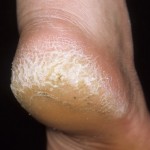Cracked Heels
Cracked heels
These are a common foot problem, often referred to as heel fissures. For most people this is a nuisance and a cosmetic problem but when the fissures or cracks are deep, they are painful to stand on and the skin can bleed – in severe cases this can become infected. The edges or rim around the heel will generally have a thicker area of skin (callus). Wearing open backed or thin soled shoes usually makes the symptoms worse.
What causes Fissures?
Some people tend to have a naturally dry skin that predisposes them to the cracks. The thickened dry skin (callus) around the heel that is more likely to crack is often due to mechanical factors that increase pressures in that area (eg the way you walk).
Other factors that can be involved in the cause of cracked heels include:
prolonged standing (at work or home, especially on hard floors)
- being overweight (this increases the pressure on the normal fat pad under the heel, causing it to expand sideways)
- open back on the shoes (this allows the fat under the heel to expand sideways and increases thesideways stresses on the area)
- some medical conditions predispose to a drying skin (eg autonomic neuropathy in diabetes, underactive thyroid)
- skin conditions (eg hyperkeratosis, psoriasis and eczema)
Self treatment for Fissures
- Applying athick hand or foot cream twice daily is really important to get on top of this problem. A pumice stone can be used to reduce the thickness of the hard skin. And avoid open backed shoes.
- Never try to reduce the hard skin your self with a razor blade or a pair of scissors. There is a risk of an infection developing and taking too much off.
Podiatric management of Fissures
The podiatric treatment of cracked heels may involve the following:
- investigating the cause of the problem, so this can be addressed if possible.
- removing the hard thick skin by debriding it (often the splits will not heal if the skin is not removed). This may need to be done on a regular basis. Regular maintenance may be the best way to prevent the problem.
- if very painful, strapping may be used to ‘hold’ the cracks together while they heal (a maintenance program after this to prevent recurrence is very important).
- Advice regarding the most appropriate moisturizer or emollient, and about footwear and self care of the problem. A heel cup may be used to keep the fat pad from expanding sideways. This is worn in the shoe and can be very effective at prevention if used regularly.




